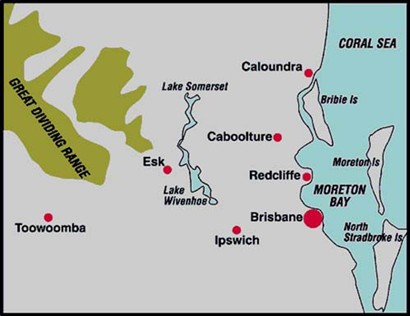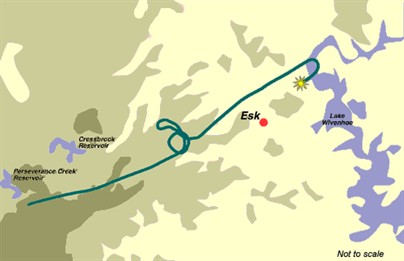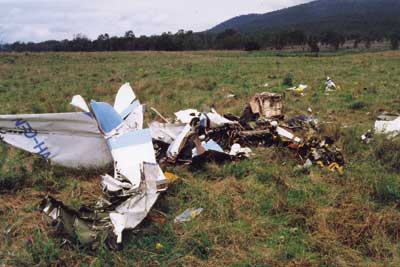One of the most dangerous situations a pilot operating under
Visual Flight Rules (VFR) could be faced with is the complete loss
of visual reference. In the last five years, 28 people have been
fatally injured in such circumstances.
VFR flight into IMC
| Year | Occurrences | Accidents | Fatalities |
|---|---|---|---|
| 1995 | 38 | 7 | 13 |
| 1996 | 34 | 1 | 2 |
| 1997 | 33 | 1 | 3 |
| 1998 | 39 | 4 | 3 |
| 1999 | 36 | 4 | 7 |
On 14 October last year, a VFR pilot with 220 hours flying
experience set off from Lightning Ridge for Caloundra in a Cessna
182 in VFR weather. Although the weather forecasts looked
reasonable when he took off, by the time he was overhead
Goondiwindi the actual weather conditions were not looking
good.

At about 1100 the radar controller noticed a secondary
surveillance radar return (code 1200), operating in close proximity
to the boundary of controlled airspace at about 5,600 feet above
mean sea level.
By the time the controller was able to talk to the pilot at
1107:57, the aircraft was inside controlled airspace bearing 310
degrees M from Amberley at 30 NM. The pilot was immediately
instructed to make a left orbit to maintain separation from an
inbound F111 with an in-flight emergency.
During the orbit, the pilot advised the controller that he was
caught in cloud and that he was in trouble. The controller tried to
clarify what was happening, and spoke to the pilot a number of
times.
By the time the controller had established that the pilot wanted
to track to Caloundra and while rated only for VFR flight was now
non-visual, the pilot had commenced a second left orbit. Half way
through the orbit, passing a heading of approximately 240 degrees,
the controller instructed the pilot to turn right and take up a
northerly heading for Caloundra.
While in the right turn, the controller asked the pilot if he
wanted to descend. The pilot replied yes and he was cleared to
leave control area on descent.
The aircraft's altitude during the turn was erratic. It
descended to 4,400 feet in less than a minute then climbed back to
4,800 feet. The pilot continued the right turn onto a heading of
about 130 degrees then began a left turn to intercept the track
from Toowoomba to Caloundra.
While the pilot was doing this, the controller told him that he
could descend safely to 3,000 feet in the aircraft's current
location. Once established on track to Caloundra, the aircraft
maintained a steady heading with a rate of descent of about 300
feet per minute.

The controller then instructed the pilot to turn right heading
130 degrees, a turn of about 90 degrees, to avoid an area of higher
terrain where the radars lowest safe altitude was 3,800 feet. The
aircraft was passing through 3,700 feet when the turn began.
The aircraft continued to turn
through the assigned heading and its ground speed and rate of
descent increased. Its radar return disappeared from the radar
display at about 1116 as it was passing through 3,200 feet on a
heading of approximately 210 degrees.
The pilot's last broadcast was at about 1116 in response to a
question from the controller.
The wreckage of the aircraft was located about 6.5km north of
Esk on flat pastoral land. A nearby resident had called the
emergency services at 1117:30 after he had observed a plume of fuel
and debris.
The aircraft was in a left spiral dive when it impacted the
ground. The weather was showery and cloud covered the tops of the
hills. The aircraft was destroyed.
Some safety lessons
Air Traffic Services (ATS) emergency procedures are outlined in
chapter 17 of the Manual of Air Traffic Services (MATS), which is a
joint military/civil document. It covers the declaration of
emergency phases and outlines procedures for handling in-flight
emergencies, including situations involving flight confined to
Visual Meteorological Conditions (VMC) but operating in Instrument
Meteorological Conditions (IMC).

According to MATS, a pilot faced with this situation would have
difficulty maintaining headings and altitude and perceiving
aircraft attitude. ATS should try to reassure the pilot and limit
communications to avoid diverting the pilot's attention from flying
the aircraft.
Airservices Australia's In-flight Emergency Response (IFER)
Training Manual gives more detailed guidance for handling a VFR in
IMC situation. This manual advises Air Traffic Controllers to help
an inexperienced pilot in distress with some reminders on aircraft
handling such as concentrating on aircraft attitude (steady
heading, wings level, constant speed); trusting what the
instruments say; and when manoeuvring make gentle movements (climb,
turns, descents) and to turn first then establish straig
ht and level before climb or descent.
Controllers could also help a pilot by giving navigational
information that would help to re-establish the aircraft in VMC. In
communicating with the pilot, controllers should keep instructions
simple and distractions to a minimum, while also instilling
confidence and providing reassurance. It is also important to pass
only one item at a time.
According to the IFER manual, communication style is important.
It states that a VFR pilot in an IMC situation is under
considerable stress and there is a need for ATS staff to convey
empathy, patience and confidence. This would require staff to adopt
a different technique to the customary delivery of information. It
was vital that questions were not put in an interrogative
manner.
The ATSB found that there was no record that the Australian
Defence Force (ADF) had received copies of the IFER training manual
from Airservices, and it, or an ADF equivalent, was not held at any
ADF ATS unit. However, ADF units did hold copies of the Airservices
IFER checklist, a document separate from the IFER training
manual.
 According to the
According to the
ATSB's investigation the controller communicated with the pilot in
an authoritative manner and questions were posed in an
interrogative style. ATS staff referred to the IFER checklist, but
were unaware of the more detailed guidance contained in the
training manual.
Outcomes
As a result of concerns regarding military air traffic control
officers' awareness of in-flight emergency response practices and
procedures for civil aircraft, the Bureau issued interim
recommendation IR 19990190 to the Australian Defence Force on 16
December 1999. The ATSB recommended that the ADF review IFER
training for air traffic services staff responsible for the
provision of services to civil aircraft.
As a result, the ADF undertook a comprehensive review of IFER
training, procedures and practices. The review concluded that
Defence IFER management and training was capable of improvements
and the Chief of Air Force directed that 11 recommendations arising
from the review be implemented by 30 June 2000. The recommendations
included enhancements to abinitio and post-graduate IFER training,
establishment of dedicated training officer positions within ATC
flights and development of a formal Supervisors course,
incorporating IFER and team/crew resource management
instruction.
Despite the ATS issues that came to light after this tragic
accident, the pilot flew on into IMC, a situation that was beyond
his skills and experience. It is likely that he became spatially
disoriented and lost control of the aircraft soon after descending
through 3,200 feet.


